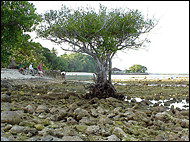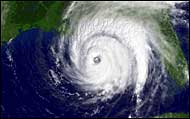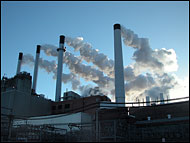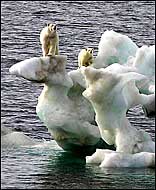A Reexamination of Climate Change Issues
Section Directory: An Examination of the Effects of a Warming Climate
updated October 13, 2022
Many people are under the impression that the effects of Carbon Dioxide being put into the atmosphere by man’s activities will cause catastrophic and irreversible environmental damage to planet Earth— a view that is reinforced by hundreds of millions of websites, many documentaries, rhetoric from politicians, environmental groups, organizations such as the United Nations, and news stories continually put out by many mainstream sources.

An examination of the real effects of climate change show that claims of potential detrimental effects are usually extremely exaggerated or false.
This section directory contains articles that examine each of the major claims about potential detrimental effects related to global warming, including melting ice and sea level issues, storm intensity issues, potential of the spread of disease and human deaths, and plant and animal species extinction.
The findings may surprise you, as most commonly assumed effects of global warming are shown to usually be extremely exaggerated and in many cases completely false.
.
This page is a part of A Reexamination of Climate Change Issues
Article Notes
new:
October 13, 2022 - Articles in this section have been updated.
Jump to parts of this section directory ..
Sea Level Issues Related to Global Warming
This section examines issues concerning potential sea level rise due to melting ice associated with the warming of the Earth’s climate. It shows how the issue of rising sea levels is extremely exaggerated by many media outlets as well as by organizations such as the United Nations’ Intergovernmental Panel on Climate Change (IPCC).
It is shown that sea levels have not been rising much at all during the past century, and many experts think that sea levels will not rise by any significant amount over the next century, contrary to current IPCC estimates as well as Al Gore’s wildly exaggerated claim of a potential rise of 20 feet. It is shown that as climate temperatures warm, ice melting on the edges of large bodies of ice such as Greenland are replaced with extra ice accumulating on the interior of those bodies due to increased precipitation from freezing rain and snow.
This section examines issues concerning potential sea level rise due to melting ice associated with the warming of the Earth’s climate. It shows how the issue of rising sea levels is extremely exaggerated by many media outlets as well as by organizations such as the United Nations’ Intergovernmental Panel on Climate Change (IPCC).
It is shown that sea levels have not been rising much at all during the past century, and many experts think that sea levels will not rise by any significant amount over the next century, contrary to current IPCC estimates as well as Al Gore’s wildly exaggerated claim of a potential rise of 20 feet. It is shown that as climate temperatures warm, ice melting on the edges of large bodies of ice such as Greenland are replaced with extra ice accumulating on the interior of those bodies due to increased precipitation from freezing rain and snow.
updated November 18, 2009
This article is a summary and partial transcript of an interview with sea level expert Dr. Nils-Axel Mörner, from the Executive Intelligence Review, June 22, 2007. Mr. Mörner speaks about how sea levels have actually been relatively stable since the early part of the past century, and how the United Nations' Intergovernmental Panel on Climate Change (IPCC) has been making use of inaccurate methods of sea level measurement, as well as not making use of actual sea level specialists as the authors for their reports. Also explained is a well-known 50 year old tree in the Maldives that proves that the sea levels have not risen significantly during the life of the tree.
updated November 29, 2009
These excerpts from the book “Unstoppable Global Warming— Every 1,500 Years” explains the realities of sea level issues including why there is actually little danger of sea levels rising much during the next century, and why claims made in Al Gore’s movie “An Inconvenient Truth” predicting a potential sea level rise of 20 feet are wildly unrealistic.
February 13, 2005
This article is an excerpt from a posting on the website ClimateAudit.org which cites a Dutch study showing that sea levels in Holland have not recently been rising, as well as casting doubts no the validity of measurements by the United Nations’ Intergovernmental Panel on Climate Change (IPCC).
November 18, 2009
Two scientific papers published by the website “ScienceMag.org” explain how ice builds in the center of large bodies of ice such as Greenland as it melts around the edges, as well as showing that ice fluctuations have been relatively constant in Greenland over the past 17 years.
Sea Level Issues - from “Global Warming or Global Governance?”
This video clip from the documentary “Global Warming or Global Governance” explains why the sea levels of the Earth will not rise by a significant amount over the next century, and it debunks some of the exaggerated claims about the effects of recent climate warming, such as the issue of supposedly declining polar bear populations.
While Al Gore claimed that sea levels could rise by as much as 20 feet over the next century due to ice melting on the edge of the Arctic and Greenland, it is shown that those claims are false due to the fact that as ice melts on the edges of those bodies, it tends to accumulate more in their centers due to increased precipitation.
On July 25, 1942, two B-17 Flying Fortresses were forced to make an emergency landing on Greenland’s southern ice cap. The crew was rescued, but the planes were left on the ice. In 1988, a team was led to find the missing planes. They expected to find the planes within 40 feet of the surface, but they eventually found them 268 feet under the ice. The team used hot water to extract a plane, and it is now flying again. It is shown that the ice simply accumulated on top of the plane rather than pushing over it due to the plane being fully intact when it was extracted.
This video clip from the documentary “Global Warming or Global Governance” explains why the sea levels of the Earth will not rise by a significant amount over the next century, and it debunks some of the exaggerated claims about the effects of recent climate warming, such as the issue of supposedly declining polar bear populations.
While Al Gore claimed that sea levels could rise by as much as 20 feet over the next century due to ice melting on the edge of the Arctic and Greenland, it is shown that those claims are false due to the fact that as ice melts on the edges of those bodies, it tends to accumulate more in their centers due to increased precipitation.
On July 25, 1942, two B-17 Flying Fortresses were forced to make an emergency landing on Greenland’s southern ice cap. The crew was rescued, but the planes were left on the ice. In 1988, a team was led to find the missing planes. They expected to find the planes within 40 feet of the surface, but they eventually found them 268 feet under the ice. The team used hot water to extract a plane, and it is now flying again. It is shown that the ice simply accumulated on top of the plane rather than pushing over it due to the plane being fully intact when it was extracted.
Storm Intensity Related to Global Warming
Media outlets frequenly attribute news stories about extreme weather to being the effects of global warming. However, studies of hurricane and tornado frequency and intensity over the past century show that there are no increases that can be associated with global warming, and it is shown than an increasingly warmer climate actually serves to lessen the strength of hurricanes due to a combination of factors such as wind shear removing the top of the hurricanes.
Media outlets frequenly attribute news stories about extreme weather to being the effects of global warming. However, studies of hurricane and tornado frequency and intensity over the past century show that there are no increases that can be associated with global warming, and it is shown than an increasingly warmer climate actually serves to lessen the strength of hurricanes due to a combination of factors such as wind shear removing the top of the hurricanes.
November 18, 2009
This article contains excerpts from an article by Chris Landsea which was published in May of 2007, showing that the number of hurricanes occurring in recent decades is no higher than during the first half of the 20th century, contrary to previous reports which did not use accurate means of recording historical hurricane activity.
November 18, 2009
This article contains excerpts from a NOAA study showing that the warming of the earth’s climate has not effected the strength or intensity of United States tornado activity during the past century. The study explains that while graphs often give an appearance of increased tornado activity, it is only due to improved levels of monitoring rather than an actual increase in tornadoes.
November 18, 2009
This article contains excerpts from a study by Roger Pielke and Christopher Landsea which “normalizes” the trends of the costs of hurricane damage over the past century. The report shows that after corrections have been factored in there is no link between global warming and the amount of damage caused by storm intensity.
November 18, 2009
An article on the website Phyorg.com describes a recent scientific paper by Gabriel A. Vecchi that explains how normal climate variations have a larger effect on hurricane activity than the effects of global warming. Also a 2007 paper by Gabriel Vecchi shows that increased wind shear from warming sea temperatures makes it more difficult for hurricanes to form and grow.
Links of Global Warming to Extreme Weather - from “Global Warming or Global Governance?”
This video clip explains that extreme weather activity such as tornadoes and hurricanes are not made stronger by the warming of the Earth’s climate, and in fact such storms are decreased in severity due to such warming.
It is often reported that hurricanes, blizzards, droughts and floods are increasing, and global warming is the cause. However, historically storm frequency and storm intensity has been greatest during colder periods. For example, storms were much more extreme during the the “Little Ace Age” between 1550 and 1850 AD. The extreme weather during that time also caused crop failures and starvation, and it was a very difficult time to live.
It is shown that the active 2005 hurricane season is not associated with global warming according to data from the National Hurricane Center, which shows that there is no correlation between hurricanes and the warming climate over the past 150 years. For example there were many more hurricanes between 1941 and 1950 than there are today.
Research at the National Oceanic and Atmospheric Administration (NOAA) is showing that global warming may actually decrease global warming, due it increasing wind sheer over tropical waters, such as during the 2006 El Nino year when no hurricanes struck the United States at all.
(A NOAA animation is also show explaining how wind sheer due to warmer temperatures works to help dissipate hurricanes.)
This video clip explains that extreme weather activity such as tornadoes and hurricanes are not made stronger by the warming of the Earth’s climate, and in fact such storms are decreased in severity due to such warming.
It is often reported that hurricanes, blizzards, droughts and floods are increasing, and global warming is the cause. However, historically storm frequency and storm intensity has been greatest during colder periods. For example, storms were much more extreme during the the “Little Ace Age” between 1550 and 1850 AD. The extreme weather during that time also caused crop failures and starvation, and it was a very difficult time to live.
It is shown that the active 2005 hurricane season is not associated with global warming according to data from the National Hurricane Center, which shows that there is no correlation between hurricanes and the warming climate over the past 150 years. For example there were many more hurricanes between 1941 and 1950 than there are today.
Research at the National Oceanic and Atmospheric Administration (NOAA) is showing that global warming may actually decrease global warming, due it increasing wind sheer over tropical waters, such as during the 2006 El Nino year when no hurricanes struck the United States at all.
(A NOAA animation is also show explaining how wind sheer due to warmer temperatures works to help dissipate hurricanes.)
Spread of Disease and Human Deaths Related to Global Warming
This section examines claims that the effects of a warming climate can have a detrimental effect on the health of people. Media outlets often make claims that such ailments as Asthma, death due to heat stroke and heart attacks, famine, and the spread of insect-borne diseases are on the rise due to global warming, but an investigation into each of those claims shows that they are almost always false or exaggerated.
This section examines claims that the effects of a warming climate can have a detrimental effect on the health of people. Media outlets often make claims that such ailments as Asthma, death due to heat stroke and heart attacks, famine, and the spread of insect-borne diseases are on the rise due to global warming, but an investigation into each of those claims shows that they are almost always false or exaggerated.
December 11, 2006
Media outlets frequently report that serious health risks such as asthma are increasingly resulting from air pollution and global warming, but the reality is that air quality has been greatly improving for decades, and fears are being instilled in people for the purpose of empowering decpetive bureaucratic agendas.
This article contains an example of a public service announcement which exploits fears of asthma being created by air pollution and global warming, and then it presents excerpts from a National Center for Policy Analysis document entitled Facts Not Fear on Air Pollution which explains realities of air pollution in the United States. The document also explains how air pollution issues are being distorted by politicians and media outlets for spreading fear of health risks for the purpose of political gain.
This article contains an example of a public service announcement which exploits fears of asthma being created by air pollution and global warming, and then it presents excerpts from a National Center for Policy Analysis document entitled Facts Not Fear on Air Pollution which explains realities of air pollution in the United States. The document also explains how air pollution issues are being distorted by politicians and media outlets for spreading fear of health risks for the purpose of political gain.
updated November 29, 2009
It is found that colder climate temperatures have a greater impact on human mortality than warmer temperatures, yet media reports often make exaggerated claims about the health dangers of a warmer climate due to global warming.
Deaths and illnesses do exist due to heat waves— including from heat stroke, heart attacks, and asthma attacks. But many health dangers are associated with cold weather as well, such as accidents due to slipping on ice, increased aliments such as cardio-vascular disease, stroke, and respiratory diseases such as colds, flu, and pneumonia.
Even more important than comparisons of hot and cold weather in determining which causes higher mortality is the fact that even under the most extreme projections for the warming of the climate, it is shown that summer temperatures would only rise by a small amount while winter temperatures would rise more significantly— thus resulting in curtailing of cold weather ailments while not increasing summer illnesses by a significant amount.
Deaths and illnesses do exist due to heat waves— including from heat stroke, heart attacks, and asthma attacks. But many health dangers are associated with cold weather as well, such as accidents due to slipping on ice, increased aliments such as cardio-vascular disease, stroke, and respiratory diseases such as colds, flu, and pneumonia.
Even more important than comparisons of hot and cold weather in determining which causes higher mortality is the fact that even under the most extreme projections for the warming of the climate, it is shown that summer temperatures would only rise by a small amount while winter temperatures would rise more significantly— thus resulting in curtailing of cold weather ailments while not increasing summer illnesses by a significant amount.
updated November 29, 2009
Historically, human food production has increased and flourished during periods of global warming, such as during the Medieval Warm Period between the years 800 and 1300 AD. However, studies show that a warming climate would bring an increased risk of drought in certain regions of the world including California, Mexico, and southern Africa, although the climate shifts would happen very gradually, giving time for populations to adapt with improved farming technology. Droughts are also shown in occur in periods of global cooling.
Species Extinction Due to Global Warming
An overwhelming amount of claims are made about extinctions and endangerment of plant and animal species resulting from the effects of global warming, however it is shown that such claims are nearly always not accurate, as all plant and animal species existing today have lived through hundreds of cycles of more extreme climate temperature variations in the past thousands of years.
Two species that are very often falsely associated with being endangered due to the effects of global warming are coral reefs and polar bears— with many millions of websites claiming extinction threats of corral reefs, and a tremendous amount of such claims existing for polar bears as well. However, it is proven very conclusively that neither is realistically threatened by global warming, as “bleaching” of coral reefs is shown to actually be a natural occurrence, and U.S. Government reports claiming polar bears to be endangered have been shown to be highly unscientific in Congressional hearings.
Genuine extinction threats to plant and animal species include hunting by humans, toxic pollution, land use by humans, introduction of alien species into foreign ecosystems, and natural disasters such as volcanoes and asteroids hitting the Earth.
An overwhelming amount of claims are made about extinctions and endangerment of plant and animal species resulting from the effects of global warming, however it is shown that such claims are nearly always not accurate, as all plant and animal species existing today have lived through hundreds of cycles of more extreme climate temperature variations in the past thousands of years.
Two species that are very often falsely associated with being endangered due to the effects of global warming are coral reefs and polar bears— with many millions of websites claiming extinction threats of corral reefs, and a tremendous amount of such claims existing for polar bears as well. However, it is proven very conclusively that neither is realistically threatened by global warming, as “bleaching” of coral reefs is shown to actually be a natural occurrence, and U.S. Government reports claiming polar bears to be endangered have been shown to be highly unscientific in Congressional hearings.
Genuine extinction threats to plant and animal species include hunting by humans, toxic pollution, land use by humans, introduction of alien species into foreign ecosystems, and natural disasters such as volcanoes and asteroids hitting the Earth.
updated October 13, 2022
Government reports over recent years have been claiming imminent extinction threats of polar bears due to the effects of global warming, and in January of 2008 those reports had been discredited as being unscientific in Congressional Hearings. Nonetheless, in May of 2008 the polar bears had been listed as a threatened species due to pressure from media and lobbying groups— which set a new precedent representing the first linkage of species endangerment to the effects of global warming. Polar bear populations actually have been increasing in the Arctic due to hunting restrictions which have been imposed years ago.
This article contains a summary of issues concerning the effects of global warming on polar bear population sizes, and well as related political and media issues.
This article contains a summary of issues concerning the effects of global warming on polar bear population sizes, and well as related political and media issues.
updated August 31, 2020
When the 1998 El Niño raised the temperatures of the waters in the Pacific Ocean, it caused widespread “bleaching” of coral reefs, which is shown to be a natural response to temperature changes of water in scientific studies. The resulting change in the appearance of corals around the world was enough for many to proclaim that the world’s corals were “dying off en mass” due to global warming, despite the fact that corals have lived through hundreds of relatively recent historical cycles of glacial periods interspersed with warm periods, as well as higher acid concentrations in the water and sea level rise of as much as 400 feet.
Article Tree
| A Reexamination of Climate Change Issues |
| Section Directory: An Examination of the Effects of a Warming Climate |


































